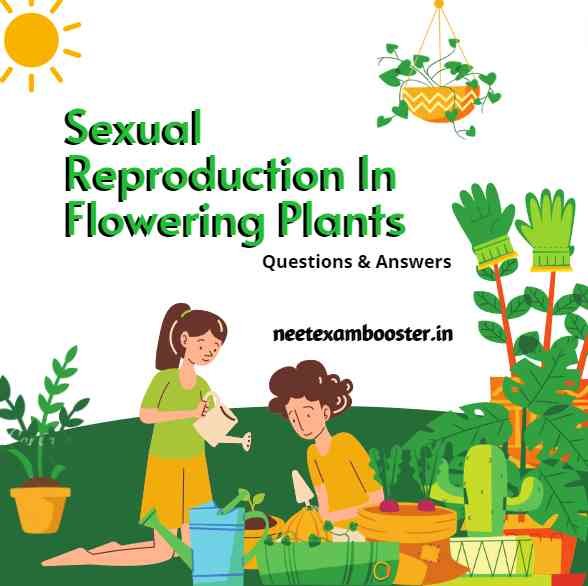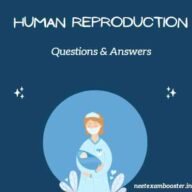Sexual Reproduction In Flowering Plants Class 12:- Flower is the reproductive part of the plant It enhance the beauty of the plant.Flower have their own colour,own scent,and they produces their own food by the process of photosynthesis.Here we are going to learn about the flower helps in sexual reproduction of the plants.Their are so many parts of the flower such as carpel,pistil,androecium, gynoeciume etc. Androecium contains stamens which is the part of the male reproductive organs and the gynoeciume contains pistil that is the female reproductive organ.Flower helps in the pollination.
Sexual Reproduction In Flowering Plants Class 12 Chapter 2

Sexual Reproduction In Flowering Plants Class 12 – Very Short Answer Type Questions
Q.1. Which are the component cells of egg apparatus in an embryo sac?
A.1. An egg apparatus consists of following parts:
- One egg cell
- Two synergids cell
Q.2. Write the name of the part of gynoecium that determines the compatible nature of pollen grain.
A.2. Stigma determines the compatible nature of pollen grain.
Q.3. Write the common function performed by nucellus and cotyledon.
A.3. Cotyledons and the nucellus both store reserve food material and provide nurishment- nucellus (embryo sac), cotyledons (embryo).
Q.4. Fill the missing words:
Pollen mother cell → Pollen tetrad → Pollen grain → Vegetative cell, ___?____
A.4.The missing word is Generative cell
Q.5. In the given following events, it indicates the stages where mitosis and meiosis occurs (1,2,3).
The Megaspore mother cell →(1)→Megaspores→(2)→Embryo sacs→(3)→Egg
A.5. 1- Meiosis 2- Mitosis 3- Meiosis
Q.6. Write direction of pollen tube from the pollen on the stigma in embryo sac in the following diagram.
A.6.
Q.7. Write the name of the regions of pistil which form fruits and seeds.
A.7. Ovary develops into a fruit and ovule develops into a seed.
Q.8.If one embryo is formed from the synergids and other from the nucellus, during polyembryony. Write the one which is haploid and the one that is diploid.
A.8. The Embryo is developed from the synergid- haploid Embryo developed from nucellus- diploid.
Q.9. Is it possible an unfertilized apomictic embryo sac gives rise to the diploid embryo? Give the reason for this.
A.9. Yes, an unfertilized apomictic embryo sac can give rise to the diploid embryo and if megaspore develops into an embryo sac without the mitotic division, it will give rise to the diploid embryo.
Q.10.At 3-cellef stage when a pollen grain is shed , write the name of three cells which are found?
A.10. Following are the three cells are found at the three-celled stage:
- One vegetative cell and
- Two male gametes
Q.11. What is self-incompatibility?In which way the self-incompatible plants pollinate?
A.11.The Self-incompatibility is a genetic mechanism in that the growth of pollen tube in the pistil is inhibited that prevents the self pollen from fertilizing with the ovules. By cross pollination self-incompatible plants pollinate.
Sexual Reproduction In Flowering Plants Class 12 Quiz
Q.12. Write the name of the triploid tissue.How does this condition achieved in a fertilized ovule?
A.12. Endosperm is a triploid tissue in the fertilized ovule.The triple fusion, leads to the fusion of one male gamete and two haploid polar nuclei form triploid tissue.
Q.13. Apomixis require fertilization and pollination…..does they? Write the reasons for this.
A.13. Apomixis does not requires the pollination and fertilization. This is due to apomixis is a form of asexual reproduction in which female reproductive apparatus is getting used. Embryos can develop directly from nucellus or synergids.
Q.14. Write the type of carpel in the given diagram.
A.14.
- (a) It is the Multicarpellary and the syncarpous pistil of Papaver
- (b) It is the Multicarpellary and the apocarpous gynoecium of Michelia
Q.15. In which way the aquatic plants undergo pollination?
A.15. In a few aquatic plants they have flowers growing in the air. They maybe pollinated by the insects. Other plants which have their flowers submerged inside the water release their pollen in water which drifts in the water and are caught by the feathery stigma of female flowers.
Q.16. In the flowering plants each pollen grain produces male gametes . State the function of the male gametes.
A.16. One male gamete fuses with nucleus of the egg cell, and the other male gamete moves towards two polar nuclei present in the central cell and fuses with it to form a triploid primary endosperm nucleus.
Q.17. Make a list of the agents of pollination.
A.17. Pollinating agents are involved in the transfer of pollen grains from male to the female part of the flower. Examples of the Pollinating agents are Animals, birds, insects, wind and other biotic and abiotic agents.
Q.18. Define pollination.
A.18.The process of transferring pollen grains from the male anther of a flower to the flower’s female part is called the stigma known as pollination. It is the sexual mode of reproducing, that is carried out by all the flowering plants of a plant kingdom.
Q.19.Write the name of the stages of post-fertilization in plants.
A.19.Following are the stages of post fertilization:
- Endosperm development,
- Embryo improvement,
- Development of ovule into a seed,&
- Development of ovary into a fruit.
Q.20.Write the name of the male and female reproductive parts of a flower.
A.20.A flower is the reproductive part of a plant.
Male reproductive parts of the flower involve the stamen, filament and anther, that are collectively termed as the androecium.
Female reproductive parts of the flower involve carpels, pistils, stigma, style and an ovary, that are collectively termed as the gynoecium.
Q.21.Define cross-pollination.
A.21.Cross-Pollination is a complex type of pollination during which the pollen grains are transferred from anther of one flower into stigma of another flower. In this type of pollination flowers use both biotic and abiotic agents like wind, water, insects, birds, animals, and some other agents as pollinators.
Q.22.Write the meaning of double fertilization.
A.22.In plants,the double fertilization means the fusion of a female gametophyte with two male gametophytes. Double Fertilization is a complex process in all flowering plants.
Q.23.Write name of the main layers of a flower.
Following are the main layer of the flower:
- Calyx
- Corolla
- Androecium
- Gynoecium
Q.24. What is Morphogenesis?
A.24.Morphogenesis is a biological process that controls growth, development in size, shape and the structure and the distribution of cells during embryonic development of a living organism.
Q.25.What is the role of endothecium?
A.25. The endothecium protects the microsporangium and helps in the dehiscence of anther for the release of pollen grains.
Sexual Reproduction In Flowering Plants Class 12 – Short Answer Type Questions
Q.1. How can the chasmogamous bisexual flower prevents the process of self-pollination?
A.1. In the following way achasmogamous bisexual flower prevents self-pollination :
- Dichogamy: In this type of strategy, they releases pollen grain and the receptivity of the stigma are not synchronized. For eg., in sunflowers, stigma of the flower becomes receptive long after the pollen release.
- Herkogamy: In this type of strategy the male and female flowers are present at different locations. In this type ,the pollen of the flower cannot come in contact with the stigma of the same flower. For eg., Hibiscus gloriosa that is china rose.
- Self-sterility: This is a mechanism in which the growth of pollen tube in the pistil or germination of the pollen grains is inhibited. It prevents the fertilization of the ovules from the pollen of the same flower that is it prevents the self pollination. For eg., Abolition.
Q.2. Arrange the given one sequentially according to how they appear in artificial hybridization programme.
- Rebagging
- Selection of parents
- Bagging
- Dusting the pollen on the stigma
- Emasculation
- Collection of pollen
A.2. a) Selection of parents
b) Emasculation
c) Bagging
d) Collection of pollen
e) Dusting of pollen on the stigma
f) Rebagging
Q.3. How does the self-incompatibility restrict the autogamy?In which way the pollination occur in such plants?
A.3. The Self-incompatibility restricts the autogamy by a mechanism called as self-sterility. It is a genetic mechanism on that the germination of pollen grains or the pollen tube growth in the pistil is inhibited that prevents the pollen from fertilizing the ovules. Such plants pollinated by process of cross-pollination.
Q.4. Label following diagram.
A.4.
Q.5. What is polyembryony? How does it is exploited commercially?
A.5. When more than one embryo occurs in the seed, it is called as the polyembryony. It can be seen in the few citrus fruits and the wide varites of mango.The polyembryony plays a significant part in the plant breeding and the horticulture. These embryos can give rise to the virus-free plantlets and they are healthy. The hybrid varieties of these such plants and vegetables are being grown extensively. These varieties which obtained are highly productive.
Q.6. Write the difference between apomixis and parthenocarpy.Describe the benefits of each.
A.6.The parthenocarpy is different from the apomixis. In the parthenocarpy, fruit is produced without the fertilization of the male and the female gamete. This is used for the production of fruits without the seeds such as bananas and the grapes for the commercial purposes.The Apomixis is the process in that the seeds are produced without the fertilization but this process occurs in the female reproductive tract of plant. In this type, the megaspore mother cell does not undergo through the meiosis. This is used for the commercial production of hybrid varieties and in production of the virus-free varieties.
Q.7.Give the reason for this statement that is , zygote divides only after the division of the primary endosperm cell.
A.7. The Zygote requires nourishment for its growth and the division.The primary Endosperm cell provides the nourishment .This is the reason why the zygote divides only after the growth, food storage and the division of the primary endosperm cell.
Q.8. What is the reason that the generative cell of 2-celled pollen divides in a pollen tube and not of 3-celled pollen?
A.8. Generative cell divides to form the two male gametes. In the three-celled pollen, the generative cell divides into two gametes, hence, no further division takes place inside the pollen .Therefore, in the two-celled pollen, the generative cell moves down the pollen tube and divides to form the two male gametes.
Q.9. Label the following parts in the diagram given below:
Male gametes, egg cell, polar nuclei, synergid, pollen tube.
A.9.
Q.10.Describe the events that is occur after the process of fertilization in plants.
A.10.The fertilization is a vital or very important process, which takes place in all sexually reproducing organisms. In the all flowering plants,the fertilization occurs after the pollination and the germination. After this process of fertilization, these following events occur:
- Ovary converted into the fruit
- Oules converted into the seeds.
- The other remaining structures including the corolla, calyx, and other remaining parts of the androecium and gynoecium getting degenerate or fall off.
Sexual Reproduction In Flowering Plants Class 12 – Long Answer Type Questions
Q.1. Give an explanation on the pollination occurring in the chasmogamous flowers.
A.1. Chasmogamous flowers are open with their anther and the stigma exposed for the pollination. In this type of flower two types of pollinations take place:
- Self-Pollination: The self-pollination occurs when both anther and stigma mature simultaneously and come in the contact with each other.
- Cross-Pollination: In this type of pollination the self-incompatible plants are required for the proceeds of pollination.In this, anther and stigma mature at the different time so they cannot come in contact with each other.The Cross-pollination is of two types:
- Geitonogamy–In this type of pollination the pollen grains from anther transfer to the stigma of a different flower in the same plant, it is called as the geitonogamy.
- Xenogamy– In this type of pollination the pollen grains from anther of a flower get transferred to the stigma of a flower in some of the other plant, it is called as the xenogamy. This process carries the genetically different pollen to stigma.
Q.2. Explain the structure of embryo sac of a mature angiosperm. Write the role of synergids in it.
A.2.
- Cell walls of the 8 nucleate stage are organized in form of a female gametophyte or the embryo sac.
- The six out of eight nuclei are surrounded by the cell walls.
- Egg apparatus comprises two synergids and one egg cell.
- At the chalazal end the three cells that is called as antipodals are present.
- By thefusion of two polar nuclei Central cell is formed.
- The embryo sac of the angiosperms consists of 8 nuclei and 7 cells on the maturity.
- A single megaspore gives rise to the embryo sac, therefore it is called monosporic embryo sac.
Role of Synergids
The synergids are responsible for the reproduction in an angiosperm. During fertilization, a pollen tube grows into one of the synergids. The tube ceases growth, ruptures and releases two sperm cells.
Q.3. The embryo sacs of some apomictic species look normal but contain diploid cells.How they are?
A.3. The produced offsprings by apomixis species are genetically identical to the parent. In the flowering plants apomixis is used to reproduce the asexually through the seeds. In the few species, diploid egg cell do not undergo reduction division and forms an embryo without the fertilization. In the few citrus species, nucellar cells surrounds the embryo sac divide and give the rise to an embryo. It takes place in megaspore mother cell. This only undergoes mitosis and therefore produces the diploid cells in embryo sac.
Q.4. Write the characteristics features of wind, water and insect-pollinated flowers.
A.4. Following are the characteristics of wind-pollinated flowers:
- Wind pollinated flowers are not so much brightly coloured.
- They haven’t possess special odours or nectar.
- The size of flowers are small and have no petals.
- The stigma and stamens of the wind pollinated flowers are exposed to air currents.
- The pollen grain is smooth, light can be blown easily through the wind and are present in large numbers.
- The stigma of the wind pollinated flower is feathery and they can catch pollen from the wind.
Following are the characteristics of water-pollinated flowers:
- The water pollinated flower possess the small male flowers which are not clearly visible.
- The large number of pollens of water pollinated flowers are released in water which is caught by large, feathery stigma of female flowers.
- These pollen keeps floating on the surface of water until the pollens are caught by female flowers.
Following are the characteristics of insect-pollinated flowers:
- The insect pollinated flower are large with the bright-coloured petals to attract the insects.
- The insect pollinated flowers have nectar and a pleasant fragrance.
- There pollen grains are sticky in nature and can easily stick to insect’s body.
Q.5. Explain the structure of the pollen.
A.5. Pollen grains are microscopic structures that carry the male reproductive cells of a plant. This is a double-walled structure with the thin inner wall called as endospore composed of cellulose and a thick outer wall known as exospore, composed of sporopollenin.
The exospore protects the male genetic material during transportation from anther to stigma. Waxes and proteins present on the pollen surface repel the moisture and interact with the stigma.
Q.6.Write the functions of a flower.
A.6.Following are the function of a flower:
- Flower provides beauty to the plant.
- The male and the female gametophytes develops in the flowers.
- Flower helps in the development of fruit with a seed.
- It is involved in the fertilization of male and female gametes.
- It provides the sex organs of the plant.
- It provide the nectar to certain birds and insects.
- The reproductive organs of a plant is protected by the flower.
- It can produce diaspores without the fertilization.
- It also promote fertilization through crossing of sperm and eggs from the same flower or different flowers.
- Flower helps in the pollination by attracting insects and other animals prior to transferring the pollen grains.
Click here to join our telegram channel for more important questions like Sexual Reproduction In Flowering Plants Class 12



















